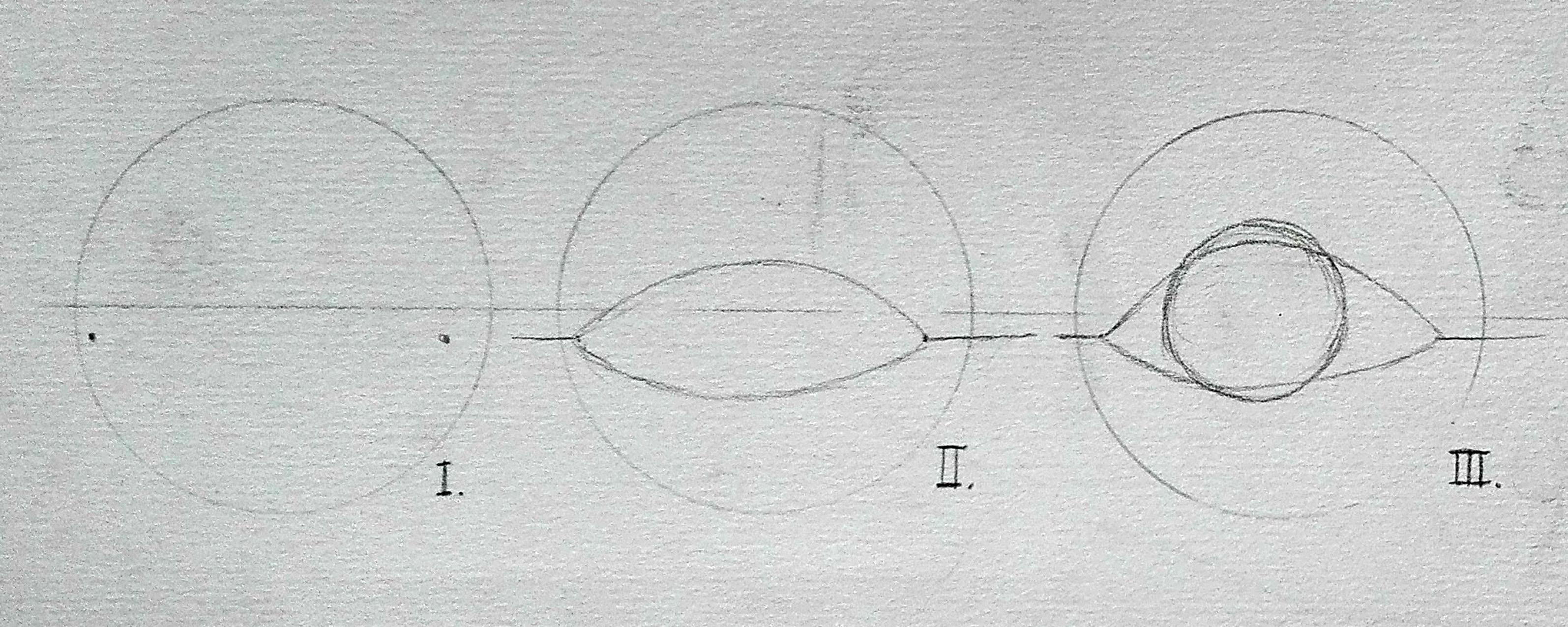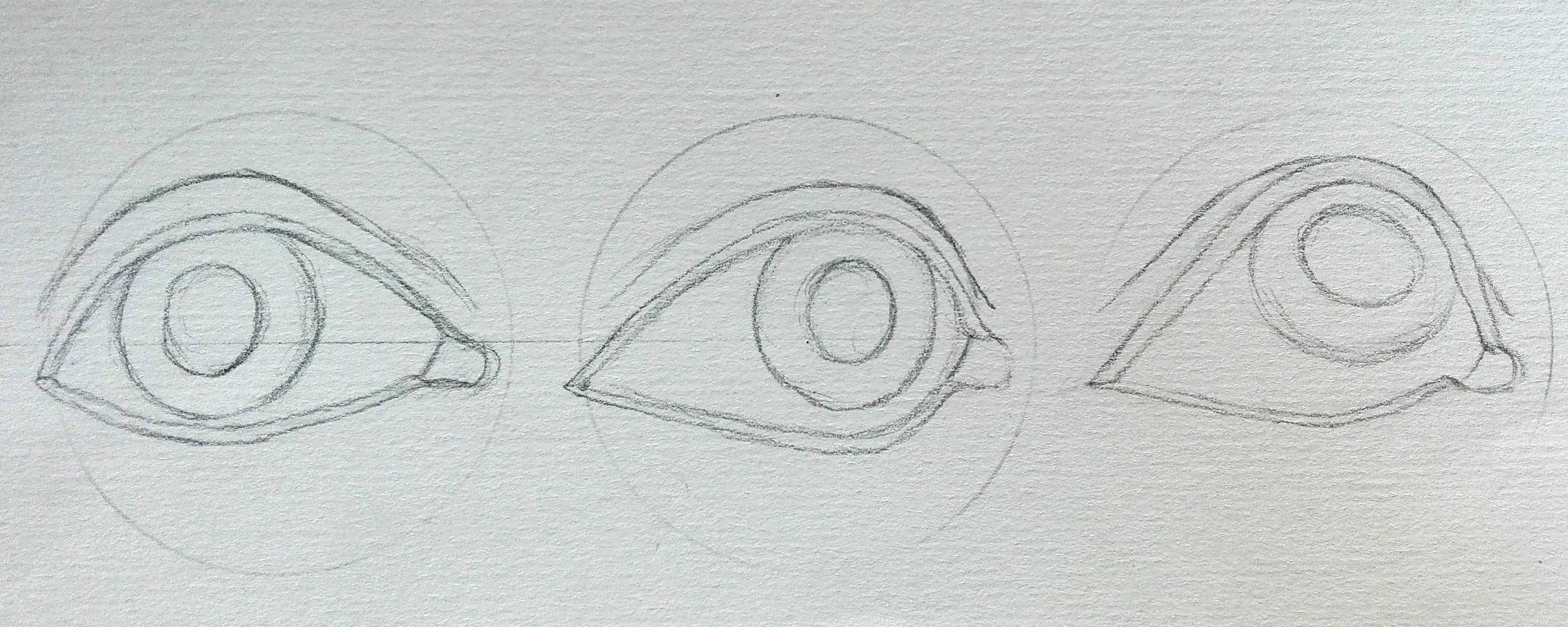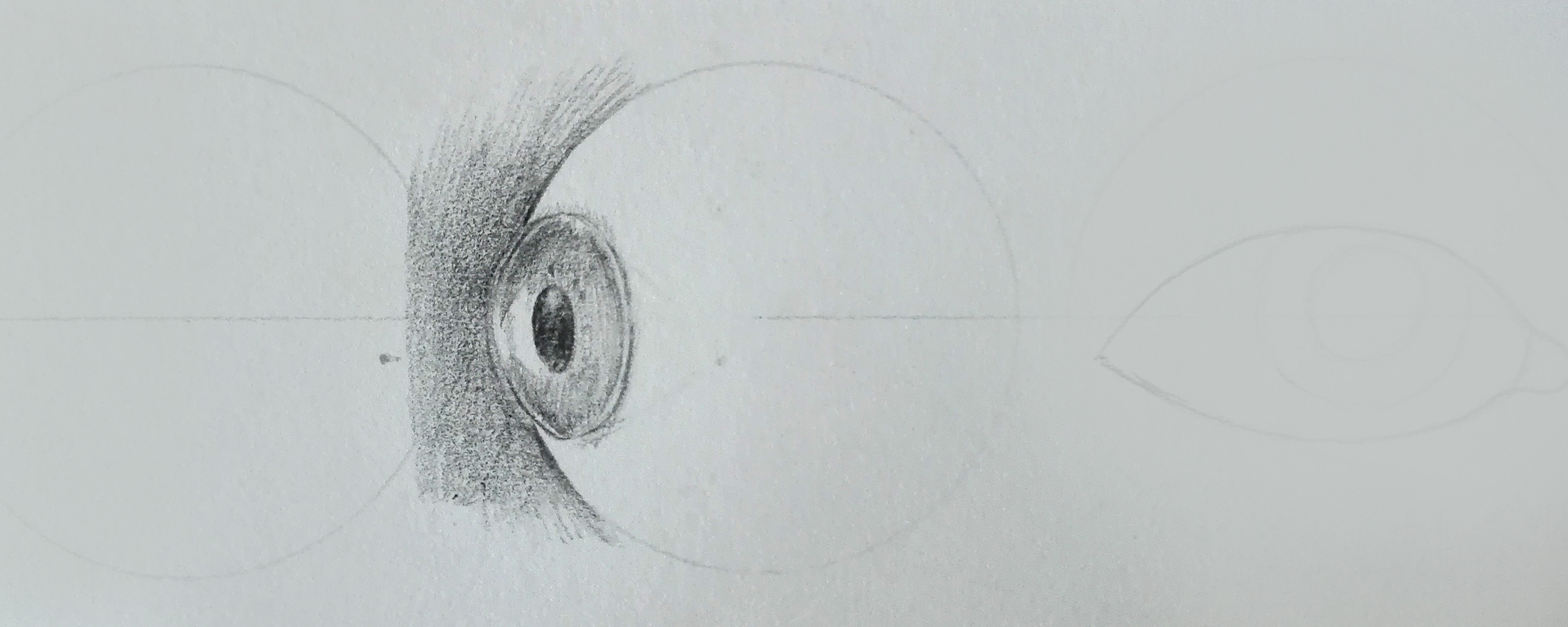What determines eye shape
To understand eye shape, it helps to think about what creates that shape.
Eyeballs are spherical. They're mostly inside the skull, but a dome of the eyeball protrudes from the eye socket. The dome is covered by a thin layer of skin with a straight slit across the diameter (eyelids). The slit is roughly, but usually not exactly, horizontal (but symmetrical). The eyelids get pulled open around the dome by muscles that open the slit from the middle, and the skin at the middle of the slit has more freedom to stretch than at the corners, so the basic shape of the opening is curved, like an arc segment of a large ellipse top and bottom.
The exact shape of the eye opening and orientation of the slit are affected by the surrounding facial structures and features, the strength of the muscles, condition of the eyelid skin, fat deposits, etc., so it's a little more complex than two arcs.
The most obvious deviation from two simple arcs is the inside (nose-side) corner. That contains a pinkish, sort of wedge-shaped nodule (lacrimal caruncle). Instead of coming to a sharp point, the upper and lower lid often do more of a tight curve around that. That results in the curve of lower lid (and sometimes the upper lid) having an inflection (reversal of the direction of the curve) at the end. Several different skin structures meet in this corner, so if you are drawing it in fine detail, there can be a lot of anatomical variation from person to person in the folds, size, and shape of that tiny spot (which means that precisely how you draw it doesn't matter that much if you aren't drawing a specific person's face).
A little more subtle deviation is that the peaks (widest spot) of the two arcs aren't the same distance from the center of the face; on the lower lid it's a little farther to the outside.
Some considerations beyond the shape of the eyelid opening
Beyond the shape of the eyelid opening, a prominent variation is the fold of the upper eyelid (or in some cases, almost no visible fold, which would be drawn with just shading). This contributes a lot to the differences in eye appearance. There are a number of common variations, some influenced by heredity, aging, or medical conditions. The "hooded" eye shape in Lyssagal's answer is largely due to the eyelid fold, and often develops with age. There are discussions online that go into detail that can be found by Googling "eyelid fold".
As Lyssagal's answer describes, common human variations and conditions, and to some extent things like race, result in some general eye shapes, but the exact shape is a continuum. If you start with the principles driving eye shape, you can vary the details quite a bit and there will be someone somewhere with eyes that look similar to what you draw. You can sketch a general shape and if it doesn't match the shape you're trying for, adjust the aspect that doesn't look right. Comparing it to pictures of actual eyes will help to identify what's off.
Keep in mind that all of this describes "at rest" open eyes. The shape of the eye opening, as well as the surrounding features, like eye brows, forehead, and cheeks, are affected by emotional expressions (and other things). Beyond just placing eye shapes properly on the face, fine tuning will let the face express emotion.
Within the opening of the lids, the location of the iris and pupil depends on where the person is looking. It will be in the center of the opening only if the person is looking straight ahead. Eyeballs rotate to a particular direction (where the person wants to look) independent of the eyelids.
That said, holding your eyeballs in a rotated position is hard; the muscles weren't designed for that. To gaze at something that isn't straight ahead, you quickly adjust your head or body so that it is. So off-center pupils would indicate more of a glance at something, like instinctively responding to something that appears in peripheral vision.
When you're drawing both eyes, there is also an influence of stereoscopic vision. If the person is looking at something in the distance that isn't straight ahead, the pupils of both eyes will be off-center (left/right and/or up/down), in the same direction and by the same amount. If the person is looking at something close to their face, the pupils will be close to the vertical middle of the eye, but both off-center horizontally a little toward the nose (the closer the object is to their face, the more cross-eyed).
Algorithmic solution
Pulling all that together into something "algorithmic", I'd suggest something like this as a starting point for the shape:
- Make some marks for the location and size of the eyes, and their centers. Sketch a rectangular box that will contain each eye.
- Sketch in the horizontal center line with the desired orientation. If it is going to be rotated off horizontal, slightly higher on the outside is more common than slightly lower on the outside.
- The rest is drawing arcs, which can be defined by a curved line passing through three points. The main arcs for the eye opening are defined by their end points and peak.
- Sketch in the upper arc. The peak will be at the top middle of the box. The curve will intersect the "horizontal" centerline at the sides of the box.
- Sketch in the lower arc. It will be a similar curve, but slightly smaller. It will intersect the "horizontal" centerline on the outside of the eye at the same place as the upper curve. The peak (if it's at the bottom, is it still a peak?), will intersect the bottom of the box slightly in the outside direction of center (maybe even with the edge of the pupil instead of the center). The arc will intersect the inside end of the "horizontal" centerline about as far from the edge of the box as the diameter of the pupil.
- With that as a framework, from the inside end of the upper arc, there will be a straight section of the "horizontal" centerline, then the lower arc will intersect it at an angle, forming a corner. You will be rounding off that corner between the centerline and lower arc with a curved line from the end of the upper arc that blends into the lower arc about a quarter of the way across the lower arc.
That gives you a starting point for a basic eye shape. You can modify and fine-tune the shape from there. The lower lid is often slightly more sharply curved at its peak than the upper lid. The upper lid usually covers more of the iris than the lower lid.
When you draw in the iris and pupil, they are often not in the vertical center of the eye opening. People often assume a posture where their head is tilted slightly forward and then they look "up" a little to see straight ahead, and shorter people look up a little for eye contact when talking to someone taller. In those cases, the bottom of the pupil will rest on the "horizontal" centerline instead of being vertically centered on it.
Here's an example of this approach.

I took the proportions from the picture of the eye in the question to see how closely the algorithm replicates the shape of that eye as a starting point. I used a pen on some graph paper and a piece of cardboard as a spline to create the arcs. Here's the procedure I used:
- I used a 7x16 grid to match the aspect ratio in the image, so 7 units by 16 units. The pupil in the image had a diameter of 2 units, so I used that.
- The eye in the picture has a centerline slightly rotated, so I tilted the horizontal centerline by 1/2 unit at the sides.
- I positioned the pupil so the left edge was at the horizontal center and the bottom edge rested on the centerline. I used a dotted line to show the pupil location.
- I put a dot at the three points that define each arc -- the end points and peak. Those locations are described above. I used a cardboard spline to create an arc connecting the three dots and traced it.
- I cut off the inside corner of the centerline and lower arc with a gradual convex arc from the end of the top arc. It merges with the bottom arc roughly 6 units from the edge of the box.
As a starting point, the three arcs give an almost perfect match to the eye in the picture. Eyes of other shapes would require a little more adjustment and cleanup, but this is a good starting point because it's based on the mechanics that drive the basic shape of the opening.



















